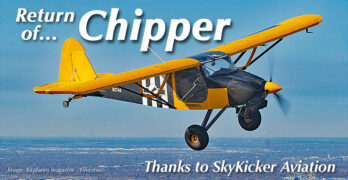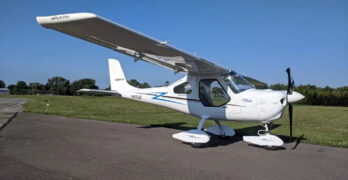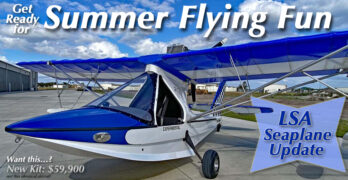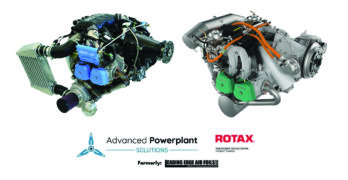Icon is a global enterprise. While its headquarters remains in Vacaville, California, fabrication is done in Mexico, and ownership is in China. For some years, this American start-up has benefitted from Chinese investment.
How much investment has this California company attracted? Numbers I’ve been quoted vary enormously but all estimates run into many millions of dollars. If these guesses are even close to accurate, Icon has generated more investment funding than nearly any LSA producer. Only one outstrips them. That was a reported $200 million sale of Pipistrel to Textron, owner of Cessna and other aviation brands. I hope the aerospace conglomerate got all they hoped for because that is a super-premium valuation for any LSA company, even one as tech-savvy as Pipistrel.
Icon has performed reasonably well in recent years (“200 Delivered” report) but prior investments in the company require sales volumes that are difficult to reach, especially with a $400,000 price tag.
So, You Want to Build An Ultralight?
Ever consider what it might be like building an ultralight? But first, how do ultralights fit into the arena of “regular” Experimental airplanes like the ones featured in KITPLANES Magazine and other Light Sport Aircraft found on this website? For those not familiar with the technicalities of an ultralight, allow me to briefly summarize the details of what defines an ultralight. Then we’ll consider how they complement their larger brothers.
While you may hear pilots and builders use the term ultralight to describe a small, light aircraft in general terms, the FAA has very specific rules as to what constitutes an ultralight. Full details are spelled out in Part 103 of the FARs, but here are the highlights.
An ultralight has a single seat (pilot-only capable), an empty weight of no more than 254 pounds and a maximum speed of 63 mph. So, if you ever see a small plane with more than one seat, or one that obviously weighs more than 254 pounds, that aircraft does not meet the legal criteria of an ultralight.
Amphib Dreams — Aero Adventure To Get New Leadership
Editor’s Note: This news release came across our (virtual) desks today and we feel it’s of interest to provide this update now. However, our man Dan Johnson has arranged to speak with current CEO Alex Rolinski in the next few days to get more detail on these changes and what to look for from Aero Adventure in the near future.
Change is coming to Aero Adventure, maker of the Aventura amphibs. According to the company, “this month, our company will be under…new leadership. With a highly experienced and respected professional team, the company is about to enter a new era of innovation and expansion.”
The company has already been making progress. “Since the beginning of 2022, we have focused on solidifying and accelerating our production process, our new team has taken us to the next level. We changed the production process, adding state-of-the-art CNC equipment. Today, we have a production capacity of 18 kits per year and plan to expand to 24 kits by 2025.”
Modifications to the Aventura are on the way as well.
Like Phoenix Rising, Belite Chipper Returns to Production by SkyKicker Aviation
Welcome back to the airplane equivalent of an old friend. As you can see at the bottom of this post, Videoman Dave and I did many video interviews with Chipper creator. James Weibe (view at bottom). Pilots seemed always to enjoy hearing about his latest development.
James came to aviation from the computer business, where the pace isn’t fast — it’s furious! Over the years Dave and I covered James and his output, we’d make a new video at every airshow, it seemed, as he had moved on from the last design to the next. That’s what they do in the world of computers but it made pilots’ heads spin.
It also probably slowed sales because, as with computers, why buy this airplane when the next one will be even better?
It Began with Kitfox Lite
James started out with the Kitfox Lite single place Part 103 ultralight vehicle. Current Kitfox owners did not plan to pursue the single seater that Kitfox founder Dan Denney had created years earlier.
Reorganization Approved: Van’s Emerges From Chapter 11
While the world of LSAs is diverse enough that the trials of Van’s Aircraft, which put itself into Chapter 11 bankruptcy protection late last year, aren’t quite the foundational matters they are among the homebuilt crowd, the fact that Van’s is represented with the popular RV-12 and companies that support it are also part of the LSA ecosystem suggests more than a little spillover. In the background, Van’s has been working hard to reset its business and emerge from Chapter 11. And on May 15 the company received good news in the form of an Oregon judge approving the company’s reorganization plan. While it seemed unlikely, there was always the possibility that the court would reject or modify the company’s proposal.
In the proposal, Van’s has agreed to repay unsecured creditors 55% of the money they’re owed over three years on top of an “immediate” repayment of $3350 for those in the unsecured creditor class.
Affordable Aeromarine Merlin LSA — What’s New?
When thinking of affordable aviation, it’s impossible not to talk about the Aeromarine Merlin LSA. This aircraft is a familiar design for many, as it made its premier in 2016. We’ve talked about it here several times. There have been some exciting changes and updates, a few of which we learned about last month at Sun ’n Fun.
The Aeromarine designed and built 60-hp V-twin liquid cooled four-cycle engine now comes as the standard powerplant. This is a modern engine with electronic ignition, electronic fuel injection and an electric starter. Merlin says this engine will cut fuel consumption at cruise to an average of 2.5 gph, approximately 50% less than the Rotax 582. The Rotax engine is still available as option for those builders that prefer.
The Aeromarine Merlin LSA will also feature as standard a deluxe MGL 8.5-inch EFIS with ADS-B In and Out (FIS-B) avionics panel, elevating your flying experience to the 21st century.
Summer’s Almost Here! State-of-the-Sector Report for LSA Seaplanes
One of the most active sectors in light aviation is LSA seaplanes. We’ve seen ups and downs, arrivals and departures of LSA seaplane producers. Admittedly, these flying machines are more complex than current-day LSA. For example, amphibs need retractable landing gear and substantial boat hulls able to take water loads.
LSA seaplanes constitute a highly fluid market yet we can see clues suggesting what might be ahead for some of the main brands. With summertime approaching, this State-of-the-Sector article attempts to keep up with the rapidly changing landscape (or waterscape).
We’ll first look at two high-end entries that have been in the news and conclude with present LSA seaplanes and their status in the market.
Vickers Wave
Writing for AVweb (part of Firecrown, which also owns Flying and ByDanJohnson.com plus several other publications), my fellow aviation journalist Russ Niles stated, “New Zealand-based Vickers Aircraft Company says it intends to make its first delivery of the Wave two-place amphibious aircraft to a U.S.
Not Bent — Whisper Sling Special Prop Breaks Cover
When we last wrote about the Whisper Sling, a version of the Sling LSA used in the Sling Pilot Training Academy in Torrance, California, one teeny tiny detail was left out of the story by request. It was the next piece of the puzzle, so to speak, to reduce the airplane’s sound signature and one of the places most airframers go to help reduce noise: the prop.
Not just any prop. This special “non-planar” three-blade prop designed by Craig Catto features an unusual bit of blade shape near the tips, all aimed at reducing noise while retaining or, even better, increasing efficiency. As tested on the Whisper Sling, the Catto prop showed strong thrust measurements (as seen in the video) and appears to have reduced noise, both on the ground and in the aircraft.
The key to reducing noise is to control the tip vortices.
Risen Group Plans Transatlantic Flight to OSH
You’ve heard of the Risen, Alberto Porto’s sleek, fast retractable that makes the most of its Rotax 912 power. With more than 180 mph on tap with the 912 iS, the Risen seems the perfect two-person traveling machine. It’s also one, like the Sparker, that would fit well into the new MOSAIC rules.
Well, Porto and Andrea Venturini are going to find out just how well it travels this summer. They’ve announced a “unique, record breaking flight across the Atlantic Ocean.” Only this Risen will be using the latest Rotax 916 iS, the turbocharged, 160-hp engine so many airframers are now fitting in place of the 915 iS.
For Porto and Venturini, “the plan is to cover 3200 kms or about 2000 statute miles across the Atlantic Ocean with a fuel consumption of just over 50 gallons of fuel at speeds up to 230 mph.
There’s a New Rotax Service Center In Town: LEAF Acquired By APS
Advanced Powerplant Solutions (APS) is a new company under the new ownership of Jeremy and Daniela Knoll, who you may know of AeroSport fame, that has purchased Leading Edge Air Foils, LLC (LEAF), which, among other things, was a Rotax independent service center for the central US. APS will carry on the Rotax-oriented business from LEAF from its base in Delavan, Wisconsin. They’re based at Lake Lawn Airport (C59), about 40 miles southwest of Milwaukee and 35 miles northeast of Rockford.
Joining the Knolls will be Brett Lawton, as their technical director. Jeremy and Daniela say that they are “dedicated to maintaining the legacy of LEAF while integrating innovative solutions and expanded service offerings. Customers can look forward to a comprehensive range of Rotax engines, parts, technical support, repair, and maintenance services. Our goal is to be the central hub for Rotax services in the USA, ensuring reliability, expertise, and the highest standards of customer service.”
While the company is getting spooled up, maintenance classes are on hold until Fall 2024.
- « Previous Page
- 1
- 2
- 3
- 4
- 5
- 6
- …
- 22
- Next Page »










